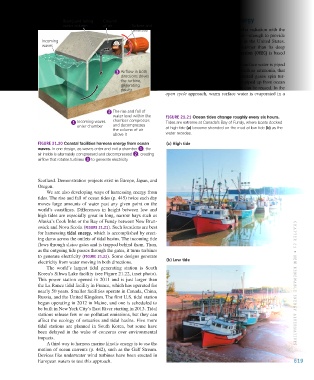Page 620 - Environment: The Science Behind the Stories
P. 620
Rising and falling Column The ocean stores thermal energy
water column of air Turbine and
generator Each day the tropical oceans absorb solar radiation with the
heat content of 250 billion barrels of oil—enough to provide
Incoming 20,000 times the electricity used daily in the United States.
waves The ocean’s sun-warmed surface is warmer than its deep
water, and ocean thermal energy conversion (otEC) is based
on this gradient in temperature.
In the closed cycle approach, warm surface water is piped
3 Airflow in both into a facility to evaporate chemicals, such as ammonia, that
directions drives boil at low temperatures. These evaporated gases spin tur-
the turbine, bines to generate electricity. Cold water piped up from ocean
generating depths then condenses the gases so they can be reused. In the
power
open cycle approach, warm surface water is evaporated in a
2 The rise and fall of
water level within the Figure 21.21 Ocean tides change roughly every six hours.
1 Incoming waves chamber compresses Tides are extreme at Canada’s Bay of Fundy, where boats docked
enter chamber and decompresses at high tide (a) become stranded on the mud at low tide (b) as the
the column of air
above it water recedes.
Figure 21.20 Coastal facilities harness energy from ocean (a) High tide
waves. In one design, as waves enter and exit a chamber 1 , the
air inside is alternately compressed and decompressed 2 , creating
airflow that rotates turbines 3 to generate electricity.
Scotland. Demonstration projects exist in Europe, Japan, and
Oregon.
We are also developing ways of harnessing energy from
tides. The rise and fall of ocean tides (p. 445) twice each day
moves large amounts of water past any given point on the
world’s coastlines. Differences in height between low and
high tides are especially great in long, narrow bays such as
Alaska’s Cook Inlet or the Bay of Fundy between New Brun-
swick and Nova Scotia (Figure 21.21). Such locations are best
for harnessing tidal energy, which is accomplished by erect-
ing dams across the outlets of tidal basins. The incoming tide
flows through sluice gates and is trapped behind them. Then,
as the outgoing tide passes through the gates, it turns turbines
to generate electricity (Figure 21.22). Some designs generate
electricity from water moving in both directions. (b) Low tide
The world’s largest tidal generating station is South
Korea’s Sihwa Lake facility (see Figure 21.22, inset photo).
This power station opened in 2011 and is just larger than
the La Rance tidal facility in France, which has operated for CHAPTER 21 • N E w R ENE wA bl E E NER gy AlTERN AT iv E s
nearly 50 years. Smaller facilities operate in Canada, China,
Russia, and the United Kingdom. The first U.S. tidal station
began operating in 2012 in Maine, and one is scheduled to
be built in New York City’s East River starting in 2013. Tidal
stations release few or no pollutant emissions, but they can
affect the ecology of estuaries and tidal basins. Five more
tidal stations are planned in South Korea, but some have
been delayed in the wake of concerns over environmental
impacts.
A third way to harness marine kinetic energy is to use the
motion of ocean currents (p. 442), such as the Gulf Stream.
Devices like underwater wind turbines have been erected in
European waters to test this approach. 619
M21_WITH7428_05_SE_C21.indd 619 12/12/14 4:29 PM

